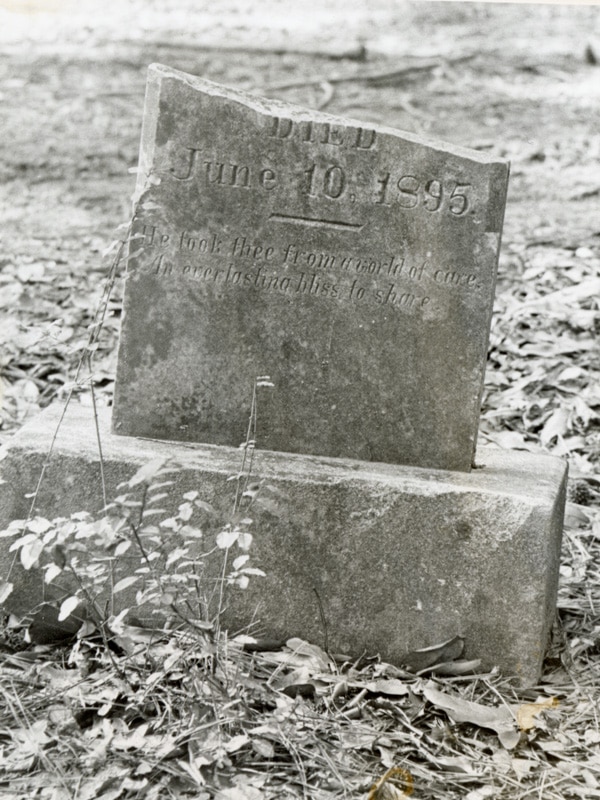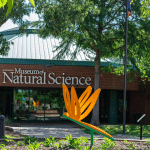The following story was provided by Gary Pettus, University of Mississippi Medical Center Office of Communications and Marketing
The construction crew digging out a new road almost a decade ago also uncovered an on ramp to a long-buried history: the resting place for more than five dozen coffins. But not the final resting place.

The accidental discovery of the remains of patients from the bygone Mississippi State Hospital for the Insane was an outrider of a tally now estimated to be in the thousands: people laid in now unmarked graves on what is today the grounds of the University of Mississippi Medical Center.
For at least eight years now, UMMC officials have sought a path that sustains campus expansion – for the sake of future patients – while honoring those patients from the past.
Now, with $3.7 million in support from the Mississippi State Legislature, the Asylum Hill Project has realized a breakthrough: funding to exhume the graves and furnish a final place of honor for the people who lie in them.
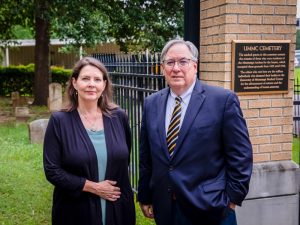
“This will allow us to bring back into the community, as best we can, their individual stories and humanity,” said Dr. Ralph Didlake, professor of surgery, associate vice chancellor for academic affairs at UMMC.
Part of the Medical Center’s overall appropriation approved during the recent 2021 legislative session, the multimillion-dollar Asylum Hill allotment makes possible the ongoing project’s second phase: exhumation and curation.
“The Legislative Budget Office and others really came to our aid,” said Didlake, director of the Center for Bioethics and the Medical Humanities at UMMC, and leader of the Asylum Hill Research Consortium, a pool of scholars gathered in 2013 to investigate the history of the asylum while respecting its patients’ legacy.
The new funds will enable the hiring of a crew of technicians, as well as a bio-archaeologist – a specialist in the study of skeletal remains – and will pay for the development of an education program.
The money will help cover the costs of archiving and storing asylum patients’ remains in the Medical Center’s archival facility on West Street, which houses a Rowland Medical Library print collection and offers temperature and humidity control, a fire suppression system, back-up electrical power, 24-hour key card security and 9,000 square feet of archival space.
That will be “interim housing,” Didlake said, for several thousand people, many of whom were African American; they will be remembered with a permanent memorial.
With the appropriation, the project is also creating space for scholars to work in, to gain knowledge that will help the world better understand the many lives represented by or connected to the coffins: those in the asylum, those of Mississippians in general, and those of people with disabilities.
The allotment will enable the Medical Center to reclaim the current burial sites for future land development.
The team to do all of this work should be in place and at it by end of this year, Didlake said. By then, guidelines will be set to direct the work “technically, ethically and culturally.”
Much of that guidance will come from an advisory board of Mississippians who will contribute a wide range of expertise; its members will engage the community and offer direction on excavation and curation work.
They will pay attention to the sensitivities, including religious ones, Didlake said. The idea is to treat these former patients as humans, not artifacts.
Carved in wood
Apparently, no one claimed the bodies of these patients before they were buried. For the most part, asylum residents have remained anonymous.
Matching many of the remains to a death record would be costly, requiring DNA testing of samples descendants provide. “DNA from each may not even be possible,” said Lida Gibson, assessments and research coordinator for the project.
“For at least some of the remains, it’s impossible at this time because of deterioration caused by high moisture content and the normal expansion and retraction of the Yazoo Clay.
“It’s important to know, though, that the graves were marked originally,” Gibson said. “Archaeologists and institutional records have established that they were marked by stone or marble, but the large majority of the markers were painted wooden stakes, all of which deteriorated.” That is why the graves are now unmarked.
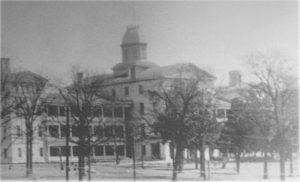
Still, completing a history of the asylum and finding descendants of as many its patients as possible are goals of the consortium, missions the National Endowment for the Humanities, as well, has boosted.
A $249,836 NEH grant announced last September made possible “An Investigation of the Mississippi Lunatic Asylum as History and Memory,” an undertaking continuing through 2023 and led by Dr. Amy Forbes, professor of history at Millsaps College, and associate professor of academic information services at UMMC.
This had followed the NEH’s $11,993 Common Heritage Grant for, among other things, video recording equipment and scanners to reproduce historical documents and publicity to encourage patients’ families to come forward.
“So far, I’ve corresponded directly with about 150 descendants/relatives, many of whom no longer live in Mississippi,” Gibson said. Many are curious about their ancestors and want to preserve their memories, she said.
They can also contribute to, or avail themselves of, the website managed by Gibson, a film documentarian who is coordinating the oral history mission.
For Gibson’s part, she continues to search for photographs, newspaper clippings, official records and more related to the asylum, documentation the descendants often supply and which can be vital in drawing a detailed picture of patients who were often marginalized when they were living.
But, as Didlake acknowledged, not all of those descendants may want the type of closure the project is offering. Some may prefer leaving their relatives where they are.
The challenge for UMMC, he said, is navigating the intersection of obligations to the asylum patients and “the ethical obligations we have to care for current and future patients.”
As to the former, Didlake said, “we’re committed to the respectful handling of their remains; we’re going to care for them because they were patients we inherited.”
But, in order to give the best care to current and future patients, the Medical Center’s footprint must be able to grow, he said.
“It can only expand on the land it has now, and some of the land holds the graves.” Many lie under the last undeveloped space on campus, he said.
At the time, among those were the graves that gave life to the Asylum Hill Project; they numbered 66, originally, with a 67th found later. It happened during road improvement work involving Peachtree Street and University Drive.
The first one emerged in November 2012 during exploratory digging of the soil, with more discoveries appearing through early spring of 2013.
Before the construction began, and because of the state-owned land’s history, the University of Mississippi Center for Archaeological Research made surveys of the area. Between September 2011 and January 2012, metal detectors, ground-penetrating radar and other methods probed the ground; they didn’t go far enough.
Because of other, ongoing construction, the survey ended just short of the area where the first 27 graves would be found. Most of the remaining 40 or so were lying under an existing road, and for that reason the area was not surveyed.
The crews who had built the existing road did not do a type of excavation called undercutting; so those burials had remained hidden for decades.
Segregation times two
The five dozen coffins unearthed in 2012 to 2013 date from the late 19th to early 20th centuries, corresponding to the asylum’s years of operation on what became Medical Center land.
“This is based on the examination of the coffin wood by our dendrochronology partners, who can sometimes pinpoint cut-dates based on tree ring patterns,” Gibson said.
A team from the Mississippi State University Department of Anthropology removed and documented the skeletal remains, steered by standards of the Mississippi Department of Archives and History in Jackson.
In 2014, during a preliminary evaluation of a site planned for a new parking garage east of the dental school, gradiometry disclosed a constellation of up to 2,000 more graves by detecting nails in the coffins. “It enabled archaeologists to ‘see’ the outline of coffins underground,” Gibson said.
UMMC officials found a new site for the parking lot.
That was not all. Another geophysical survey showed that many more coffins lie underground – as many as 7,000, estimates say — across about 12 acres of UMMC land; clearing it would free up about 18 acres for development, Gibson said.
The coffins are among the few surviving, physical reminders of what was originally known as the Mississippi State Lunatic Asylum, whose origin story is now 166 years old. The institution, the first of its kind in the state, opened in 1855 and closed in 1935, its timeline transected by the Civil War, World War I, the Great Depression’s early years and the prelude to World War II.
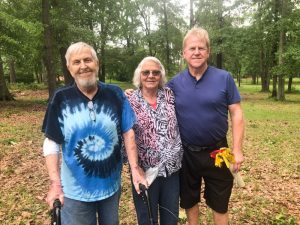
Its successor is the Mississippi State Hospital, located in a Rankin County community later renamed Whitfield. The asylum’s buildings, there were dozens, were demolished to make way in 1955 for the opening of UMMC.
During its 80-year operation in the state capital, the hospital became the permanent or temporary home of some 30,000 to 35,000 patients, situated on a tract of land that grew to 1,320 acres.
Before its founding, Mississippians could seek mental health treatment in other states, if they could afford it. The rest were “entirely without a retreat,” in the words of a 1955 Mississippi State Hospital centennial program.
Some “were riveted to the floors of county jails and dungeons, others were wearing out their own lives, as well as the lives of their friends, in misery and woe at home.”
Four stories high and 64 feet across, the hospital’s center rose alongside north State Street near what became almost the exact location of the Medical Center’s original entrance. It was connected to two wings, and the six 35-foot high columns guarding the portico supported a “Grecian Doric entablature and cornice,” as described by the centennial program. Its crown was a “handsome” dome-shaped cupola of “suitable dimensions.”
A branch line of the Mississippi Central Railroad led to a campus supported by a bakery, a carpentry shop, infirmaries and a cow shed, according to a history prepared by MDAH. Dormitories held residents who, already severed from society, were segregated again by gender and race.
“Interestingly enough, our current research indicates that there was no separation by race in the cemetery layout,” Gibson said.
In July 1863, from its main (and at that time, probably only) building, residents watched Union troops skirmish with Confederates who dissolved, like cannon smoke, into the woods.
In the MDAH account, a Union soldier describes how a patient “came to his grated window and made a speech to us,” shaking his fingers, as only a “retired politician” might do.
A diet of dementia
From a prominence called Asylum Ridge, Northern artillerymen bombarded the heart of Jackson, more than a mile away, disturbing the patients, many of whom led their own perilous lives inside.
“In 1912, the State of Mississippi started keeping birth and death certificates, including records for people who died at the asylum and were buried there,” Gibson said. “That’s how we know that there are at least 4,380 graves, dating from 1912 to 1935.
“We think we have a fairly complete list of who is buried there during those 23 years.” Knowing where each patient is buried is another matter.
Dr. Molly Zuckerman, a biological anthropologist at MSU, has said that many as 10,000 to 11,000 died there – a tragic reckoning in such a picturesque setting.
Their coffins held almost no personal items that might have helped identify them. Patients were buried in shirt dresses and shrouds; some shroud pins were found, along with buttons which had probably been sewn onto the shirt dresses.
Many patients who died had suffered from pellagra, caused by a deficiency of niacin, part of the Vitamin B complex present in such foods as fish, poultry, red meat, and fortified breads and cereals – even though, as records show, they were fed vegetables, grain, poultry, beef, pork and eggs.
Pellagra thrived in the early 20th century, especially in the South, the realm of cornmeal, fatback and molasses. It could lead to dementia, and available asylum records show that a now-abandoned psychiatric diagnosis, dementia praecox, or premature dementia, was often listed as a cause of death.
“Most sources identify it as we what now call schizophrenia,” Gibson said.
Other diagnoses included “pellagra/insanity,” “melancholia,” “general paralysis of insane,” and “maniacal exhaustion.”
Asylum residents would have included direct descendants of slaves; some might have been slaves themselves at one time. In which case, their family histories are most likely murky or lost – “except, perhaps, in family stories passed from generation to generation,” Gibson said.
Many who died were buried in a space hundreds of yards to the asylum’s east, facing the rising sun, placed in pine coffins about six feet long and built, most likely, by carpenters in the wood shop.
Over the years, the weight of the shifting clay soil damaged the bones within, while the shells of the coffins narrowed considerably – like the patients’ identities, shrinking away.
Withered history
Apparently, in the past, the Medical Center’s commitment to the memory of those patients also withered.
On Jan. 23, 1990, The Clarion-Ledger published a front-page article that began: “About 20 tombstones discarded in a gully behind the University of Mississippi Medical Center bear silent witness to forgotten history.
“George Thompson, 2554 McDowell Circle, discovered the broken slabs of marble and granite when he took a walk on the 155-acre UMC campus.”
It appeared, the article reported, that the stones had lain scattered in the depression for decades. The Medical Center had no funds to maintain them. Some of the stones were broken or lying face down. Names were visible on some. As it turned out, the markers had been moved from another cemetery site.
Quoted in the article, a MDAH historian linked them to the old asylum cemetery.
More surprises were coming, though, and long before 2012. In 1992, workers digging a ditch for a new laundry’s steam line connection exposed the first of 44 unmarked graves.
About 20 years earlier, state lawmakers had given the Medical Center permission to rebury any remains found during such projects. Dr. Wallace Conerly, then-vice chancellor, directed the creation of the cemetery that now holds those nearly four dozen remains; they lie under nameless markers, which are numbered instead.
The UMMC Cemetery also became the home of the 20-plus stones George Thompson had spotted scattered in the gully.
Today, in the cemetery, you can read the names found on these surviving stones, Gibson said. “They are listed on a plaque there.”
The tree-sheltered graveyard rests in the northeastern part of the campus. The memorial to the asylum patients will go there.
History unforgotten
As with much else in the world, the Asylum Hill Project was put on hold in 2020, or least its pursuit of state funds was. With the 2021 appropriation, its members can resume adding to a list of these and other advancements:
The Mississippi Department of Archives and History, a collaborating institution of the consortium, has made available online transcribed information from the death certificates of thousands of asylum patients.
Medical students in the Psychiatry Student Interest Group have analyzed available records from the asylum’s admission logs. Supervised by Dr. Sara Gleason, professor of psychiatry and human behavior at UMMC, this work resulted in a presentation at the Mississippi Academy of Sciences Annual Meeting in 2018.
Organized in-person and online, informational and engagement sessions have connected the endeavor with descendants, civic clubs, churches and more.
In just one example of the project’s commitment to community outreach, an audience watched a screening of an original video, “The Mississippi State Asylum: A Realm of Its Own,” on the campus of consortium member Alcorn State University in Lorman; this fell on the eve of the pandemic shutdowns, in early March of last year.
The consortium membership, too, has advanced and evolved. Among its newest members are Dr. Elizabeth West, professor of African American Studies and English at Georgia State University; and Dr. Beckie Barry, who taught dental anatomy for 25 years and served as professor and chair of dental hygiene in the School Health Related Professions at UMMC.
One of the lost markers almost certainly belonged to John Benedict Whitfill, or Whitfield, a Kentuckian who migrated to Mississippi, lured by the lucrative dream dangled by “King Cotton.”
Instead, he descended into the world of dementia, his condition apparently brought on by pellagra; that was the price he paid for starving himself so his children would have enough to eat.
In late 1931, his family committed him to the asylum – about two months before he died. Some three years later, the asylum began to vanish, too; if the Asylum Hill Project has its way, its patients’ stories will not.


